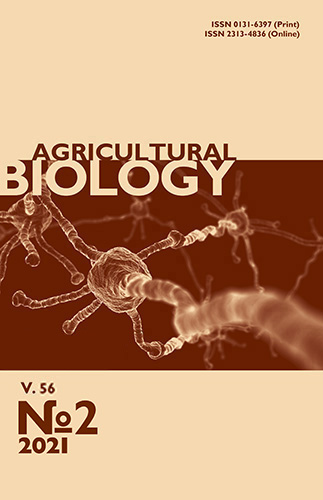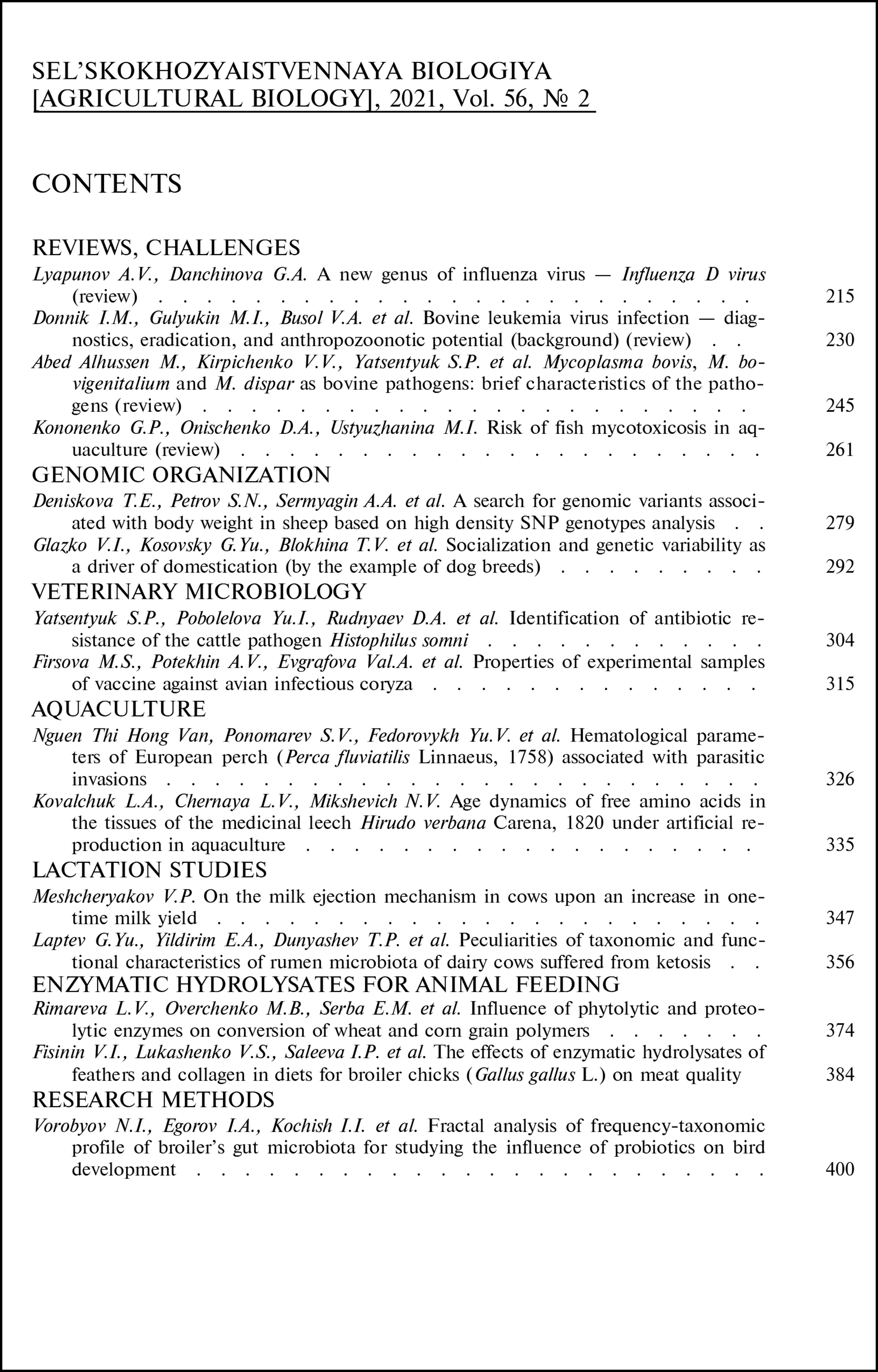doi: 10.15389/agrobiology.2021.2.326eng
UDC: 639.3.05:619:616-093/-098
HEMATOLOGICAL PARAMETERS OF EUROPEAN PERCH (Perca fluviatilis Linnaeus, 1758) ASSOCIATED WITH PARASITIC INVASIONS
Nguen Thi Hong Van, S.V. Ponomarev, Yu.V. Fedorovykh ✉,
Yu.N. Grozesku, A.A. Bakhareva, I.V. Volkova, V.I. Egorova,
Yu.V. Sergeeva
Astrakhan State Technical University, 16, Tatishcheva st., Astrakhan, Russia 414056, e-mail: Hongvannguyen@mail.ru, ya.panama2011@yandex.ru, jaqua@yandex.ru (corresponding author ✉), grozesku@yandex.ru, bahareva.anya@yandex.ru, gridasova@mail.ru, lekaego@mail.ru, js4444@mail.ru
ORCID:
Nguen Thi Hong Van orcid.org/0000-0002-6910-2705
Ponomarev S.V. orcid.org/0000-0002-2899-8672
Fedorovykh Yu.V. orcid.org/0000-0003-0789-1566
Grozesku Yu.N. orcid.org/0000-0002-6691-8696
Bakhareva A.A. orcid.org/0000-0002-7724-2425
Volkova I.V. orcid.org/0000-0001-8945-6669
Egorova V.I. orcid.org/0000-0002-7688-723X
Sergeeva Yu.V. orcid.org/0000-0001-8811-1378
Received November 14, 2019
European perch (Perca fluviatilis Linnaeus, 1758) is widespread in water basins and has a commercial value. However, in the natural environment, fish are often infected with invasive diseases, which exclude its processing for food purposes. Being in the body of fish, parasites produce toxic substances that affect various organs of fish. Widespread in the Volga Delta pathogenic species, Eustrongylides excisus, in large quantities occurs in perch in larval state in the abdominal cavity of the body, in the walls of the intestine, in the liver, in the calf and in the spinal muscle tissue, reaching up to 30 or more parasites per fish. Sexual maturity of the parasite occurs in the stomach of the birds. This disease is peculiar to perch species; larvae of this nematode cause granulomatous inflammatory reaction. In addition, these worms, penetrating deep into the muscles of the perch, spoil the commercial quality of fish, which leads to the culling of fish raw materials and rejection of foodstuff. This work, for the first time, compares the hematological status of infected and healthy perch of natural populations. The work aimed to assess biological and physiological effects of various parasitic invasions on European perch Perca fluviatilis(Linnaeus, 1758). Fish of both sexes at the age from 0 to 4 years were caught in natural reservoirs of the Lower Volga (Bolshaya Bolda and Bely Ilmen rivers, Astrakhan region) in September 2016 to June 2019. The total body length, the length to the end of the scale cover, body weight and age were determined, and the Fulton’s fatness coefficient was calculated. The skin, fins, mouth, gills, eyes, heart, abdominal cavity, muscles, brain, and spinal cord of fish were examined for parasitological contamination. Blood for analysis was taken from the tail vein in vivo. Nematodes were found in more than 55 % of the caught perch. Nematodes were found in the liver (30 %), abdominal cavity (45 %), intestines (10 %), muscles (15 %), and gills (5 %). Parasites were found free within the body cavity, or encapsulated, with Eustrongylides excisus being the most abundant. In the infected fish, the average body weight and body condition coefficient decreased as compared to the healthy fish of the same age. However, the revealed growth retardation in the infected perch was statistically insignificant (p > 0.05), while the body condition coefficient was significantly lower than in uninfected fish (p < 0.01 for 3-year-old perch). The parasitic infestation of P. fluviatilis with Eustrongylides nematode caused symptoms of anemia, suppression of erythropoiesis (i.e., a decrease in the proportion of blast forms of the erythrocytic cell series), an increase in the proportion of neutrophils, monocytes, and lymphoblasts in the leucocyte count. In infected perch, the number of red blood cells significantly decreased (83.01×104±4.17×104 vs. 137.22×104±5,26×104/mm3), as well as the concentration of total protein (40.81±1.19 vs. 48.97±2.07 g/l) and blood cholesterol (5.17±0.28 vs. 6.81±0.30 mmol/l). MCH (mean corpuscular hemoglobin), erythrocyte sedimentation rate, the total number of leukocytes and platelets also increased compared to uninfected fish. The level of pathological red blood cells increased in the infected perch (9,17±0,23 % vs. 4,87±0,11 %). Changes in cell cytoplasm and nucleus, degenerative changes in the cell, changes associated with cell division were the main types of the discovered cell pathology of the infected perch.
Keywords: Perca fluviatilis, European perch, parasites, nematodes, hematological parameters, anemia, eustrongylidosis, blood.
REFERENCES
- Fontaine P. Eurasian perch culture, a way of diversification for freshwater aquaculture. INRA Productions Animales, 2004, 17(3): 189-193.
- Raitaniemi J., Rask M., Vuorinen P.J. The growth of perch, Perca fluviatilis L., in small Finnish lakes at different stages of acidification. Annales Zoologici Fennici, 1988, 25(3): 209-219.
- O’Neill E.A., Stejskal V., Clifford E., Rowan N.J. Novel use of peatlands as future locations for the sustainable intensification of freshwater aquaculture production — A case study from the Republic of Ireland. Science of the Total Environment,2020, 706: 136044 CrossRef
- Setälä J., Laitinen J., Virtanen J., Saarni K., Nielsen M., Honkanen A. Spatial integration of freshwater fish markets in the Nothern Baltic Sea area. Fisheries Research,2008, 92(2-3): 196-206 CrossRef
- Watson L. The European market of perch (Perca fluviatilis). In: Percid fish culture, from research to production: abstracts and short communications: Namur (Belgium), 23-24 January 2008. P. Fontane, P. Kestemont, F. Teletcha, N. Wang (eds.). Presses Universitaires de Namur, Belgium, 2008: 10-14.
- Matvienko N., Vaschenko A., Nazarov A., Aishpur A. Eustrongylidosis in predatory fish species of Dnieper reservoirs. Zoology and Ecology, 2015, 25(3): 235-238 CrossRef
- Terpugova N.Yu., Kon'kova A.V., Volodina V.V., Voronina E.A. Materialy Vserossiiskoi nauchnoi konferentsii s mezhdunarodnym uchastiem «Sovremennye problemy parazitologii i ekologii. Chteniya posvyashchennye pamyati S.S. Shul'mana». Tol'yatti, 2018: 285-292 [Proc. Russian Conf. «Current problems of parasitology and ecology. Readings dedicated to the memory of S.S. Shulman»] (in Russ.).
- Volodina V.V., Kon'kova A.V., Voronina E.A. Rybnoe khozyaistvo,2015, 4: 91-93 (in Russ.).
- Menconi V., Riina M.V., Pastorino P., Mugetti D., Canola S., Pizzul E., Bona M.C., Dondo A., Acutis P.L., Prearo M. First occurrence of Eustrongylides spp. (Nematoda: Dioctophymatidae) in a subalpine lake in Northwest Italy: new data on distribution and host range. International Journal of Environmental Research and Public Health, 2020, 17(11): 4171 CrossRef
- Branciari R., Ranucci D., Miraglia D., Valiani A., Veronesi F., Urbani E., Lo Vaglio G., Pascucci L., Franceschini R. Occurrence of parasites of the genus Eustrongylides spp. (Nematoda: Dioctophymatidae) in fish caught in Trasimeno Lake, Italy. Italian Journal of food Safety, 2016, 5(4): 6130 CrossRef
- Kaur P., Shrivastav R., Qureshi T.A. Pathological effects of Eustrongylides sp. larvae (Dioctophymatidae) infection in freshwater fish, Glossogobius giuris (Ham.) with special reference to ovaries. Journal of Parasitic Diseases: official organ of the Indian Society for Parasitology, 2013, 37(2): 245-250 CrossRef
- Vasil'kov G.V. Gel'mintozy ryb. Moscow, 1983 [Helminthiasis of fish] (in Russ.).
- Aibinu I.E., Smooker P.M., Lopata A.L. Anisakis nematodes in fish and shellfish — from infection to allergies. International Journal for Parasitology. Parasites and Wildlife, 2019, 9, 384-393 CrossRef
- Eiras J.C., Pavanelli G.C., Takemoto R.M., Nawa Y. An overview of fish-borne nematodiases among returned travelers for recent 25 years — unexpected diseases sometimes far away from the origin. The Korean Journal of Parasitology, 2018, 56(3): 215-227 CrossRef
- Zhu G.-L., Tang Y.-Y., Limpanont Y., Wu Z.-D., Li J., Lv Z.-Y. Zoonotic parasites carried by invasive alien species in China. Infectious Diseases of Poverty, 2019, 8: 2 CrossRef
- Kalaida M.L., Govorkova L.K. Metody rybokhozyaistvennykh issledovanii. St. Petersburg, 2013 [Fisheries research methods] (in Russ.).
- Mlovastyi K.S. Diagnostika boleznei i vetsanekspertiza ryby: uchebnoe posobie. St. Petersburg, 2013 [Diagnostics of diseases and veterinary examination of fish: a tutorial] (in Russ.).
- Gaevskaya A.V. Parazity i bolezni ryb Chernogo i Azovskogo morei: I — morskie, solonovatovodnye i prokhodnye ryby. Sevastopol', 2012 [Parasites and diseases of fish of the Black and Azov seas: I — marine, brackish-water and anadromous fish] (in Russ.).
- Gaevskaya A.V. Parazity i bolezni ryb Chernogo i Azovskogo morei: II — poluprokhodnye i presnovodnye ryby. Sevastopol', 2013 [Parasites and diseases of fish of the Black and Azov seas: II — semi-anadromous and freshwater fish] (in Russ.).
- Fedorov N.M., Firsov N.F., Solov'ev N.A. Veterinarnaya patologiya, 2014, 3-4(49-50): 68-73 (in Russ.).
- Ivanova N.T. Nekotorye aspekty k osnovam ikhtiogematologii. Rostov-na-Donu, 2002 [Some aspects to ichthyogematology basics] (in Russ.).
- Zhiteneva L.D, Poltavtseva T.G., Rudnitskaya O.A. Atlas normal'nykh i patologicheski izmenennykh kletok krovi ryb. Rostov-na-Donu, 1989 [Atlas of normal and pathologically altered blood cells of fish] (in Russ.).
- Meditsinskaya biokhimiya: Laboratornyi praktikum. Pod redaktsiei N.A. Semikolenovoi. Omsk, 2005 [Medical biochemistry: laboratory workshop. N.A. Semikolenova (ed.)] (in Russ.).
- Lebed'ko E.Ya., Khokhlov A.M., Baranovskii D.I., Getmanets O.M. Biometriya v MS Excel. St. Petersburg, 2018 [Biometrics in MS Excel] (in Russ.).
- Guagliardo S., Viozzi G., Brugni N. Pathology associated with larval Eustrongylides sp. (Nematoda: Dioctophymatoidea) infection in Galaxias maculatus (Actinopterygii: Galaxiidae) from Patagonia, Argentina. International Journal for Parasitology. Parasites and Wildlife, 2019, 10: 113-116 CrossRef
- Kundu I., Bandyopadhyay P.K., Mandal D.R., Gürelli G. Study of pathophysiological effects of the nematode parasite Eustrongylides sp. on freshwater fish Channa punctatus by hematology, serum biochemical, and histological studies. Turkiye Parazitol. Derg., 2016, 40(1): 42-47 CrossRef
- Dezfuli B.S., Manera M., Lorenzo M., Pironi F., Shinn A.P., Giari L. Histopathology and the inflammatory response of European perch, Perca fluviatilis muscle infected with Eustrongylides sp. (Nematoda). Parasites Vectors, 2015, 8: 227 CrossRef
- Panjvini F., Abarghuei S., Khara H., Parashkoh H.M. Parasitic infection alters haematology and immunity parameters of common carp, Cyprinus carpio, Linnaeus, 1758. Journal of Parasitic Diseases, 2016, 40(4): 1540-1543 CrossRef
- Rahbar M., Khara H., Hayatbakhsh M., Ahmadnezhad M. Surveying some hematological parameters of perch (Perca fluviatilis, L. 1785) in the Anzali Wetland in Iran. In: International conference on chemical, environmental and biological sciences (ICCEBS’2011). Anzali, 2011: 324-327.
- Morozinska-Gogol J. Parasite communities of European perch, Perca fluviatilis L. (Actinopterygii: Perciformes: Percidae) from lake Łebsko (Central Coast, Poland). Annals of Parasitology, 2013, 59(2): 89-98.
- Kamshilov I.M., Zaprudnova R.A. Vestnik Mordovskogo universiteta, 2015, 25(2): 152-157 CrossRef (in Russ.).
- Kurtanidze Yu.S., Turitsin V.S. Materialy nauchno-prakticheskoi konferentsii «Nauchnyi vklad molodykh issledovatelei v sokhranenie traditsii i razvitie APK». St. Petersburg, 2016, 1: 147-149 [Proc. Int. Conf. «Scientific contribution of young researchers to the preservation of traditions and the development of the agro-industrial complex»] (in Russ.).
- Dugarov Zh.N., Pronin N.M. Ekologiya, 2017, 1: 20-27 CrossRef
- Zaprudnova R.A., Kamshilov I.M. Vestnik APK Verkhnevolzh'ya, 2013, 4(24): 56-61 (in Russ.).
- Akoll P., Konecny R., Mwanja W.W., Nattabi J.K., Agoe C., Schiemer F. Parasite fauna of farmed Nile tilapia (Oreochromis niloticus) and African catfish (Clarias gariepinus) in Uganda. Parasitology Results, 2012, 110: 315-323 CrossRef
- Petrishko V.Yu., Firsov N.F. Materialy Mezhdunarodnoi nauchno-prakticheskoi konferentsii studentov, magistrantov, aspirantov i molodykh uchenykh «Perspektivy razvitiya nauchnoi i innovatsionnoi deyatel'nosti molodezhi». Pos. Persianovskii, 2016: 159-163 [Proc. Int. Conf. «Prospects for the development of scientific and innovative activities of youth»] (in Russ.).
- Kamshilov I.M., Zaprudnova R.A., Chalov Yu.P. Biologiya vnutrennikh vod, 2014, 4: 83-85 CrossRef (in Russ.).
- Chiocchia G., Motias R. Effect of catecholamines on deformability of red cells from trout: relative roles of cyclic AMP and cell volume. The Journal of Physiology, 1989, 412(1): 321-332 CrossRef
- Voronin V.N., Golineva E.A., Dudin A.S. Parazitologiya, 2017, 51(2): 165-169 (in Russ.).
- Dugarov Zh.N., Pronin N.M. Rossiiskii zhurnal biologicheskikh invazii, 2012, 5(4): 27-35 (in Russ.).
- Pronina G.I., Koryagina N.Yu. Metodologiya fiziologo-immunologicheskoi otsenki gidrobiontov. St. Petersburg, 2017 [Methodology of physiological and immunological assessment of aquatic organisms] (in Russ.).












